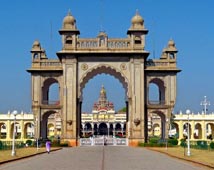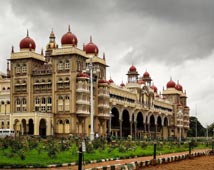
Designed for the Maharaja of Mysore by a British architect, Mysore Palace was built in 1897. The decorations inside are outrageously extravagant, proving how rich the Maharaja was at this time. The palace is spectacularly illuminated on Sunday nights, and during the festive season of Dussehra. The Mysore Palace, once the residence of the Wodeyars, is one of the largest palaces of its kind in India, and one of the most splendid.
Designed in the Indo-Saracenic style by Henry Irwin, the British consultant
architect
of Madras state, it was built in 1912 for the twenty fourth Wodeyar
Raja on the site of the old wooden palace that had been destroyed by fire
in the year 1897. Twelve temples surround
the palace, some of which are
from earlier periods.
The entry to the palace is through the 'Gombe Thotti' or the Doll's Pavilion, a gallery of Indian and European sculpture and ceremonial objects. Halfway along is the elephant gate, which is the main entrance to the center of the palace. The gate is decorated with floral designs, and bears the Mysore royal symbol of a double headed eagle. Inside there is an enclosed courtyard. To the north of the gate are dolls, dating from the earlier nineteenth and twentieth centuries, a ceremonial wooden elephant howdah (carriage kept on top of the elephants to carry royalty) decorated with 84 kilogram of 24 carat gold and other souvenirs.
Spectacular Museum
The palace has now been converted into a museum, which treasures the souvenirs, paintings, jewelery, royal costumes and other items, which were once possessed by the Wodeyars. It is said that the palace displays the largest collection of gold items, quantity wise. The Durbar hall of the palace has an ornate ceiling and many sculpture pillars which are said to have been painted with gold.

The interior of the Palace
Walls which lead to the Kalyan Mandapa or the royal wedding hall, are lined with elaborately detailed oil paintings, illustrating the great Mysore Dussehra Festival of 1930. The hall itself is magnificent, featuring chandeliers, and multicoloured stain glass arranged in peacock designs. On climbing up the stairs, is the Public Darbar Hall, or the hall for public audience, which has paintings of some celebrated artists, and offers wonderful views of the parade grounds and the Chamundi Hills. Chamundi Hills has a temple dedicated to Goddess Chamundi or Durga. The smaller Private Durbar hall or the hall for private audience, features some splendid work of beautiful stained glass and gold leaf paintings.
The Temples
There are twelve temples surrounding the palace within the compound. Some of them are built in typical Dravidian style including the Varashaswamy Temple with a gopuram that set the pattern for the later Sri Chamundeswari Temple on Chamundi Hill. On special occasions, religious ceremonies are still conducted in these temples.